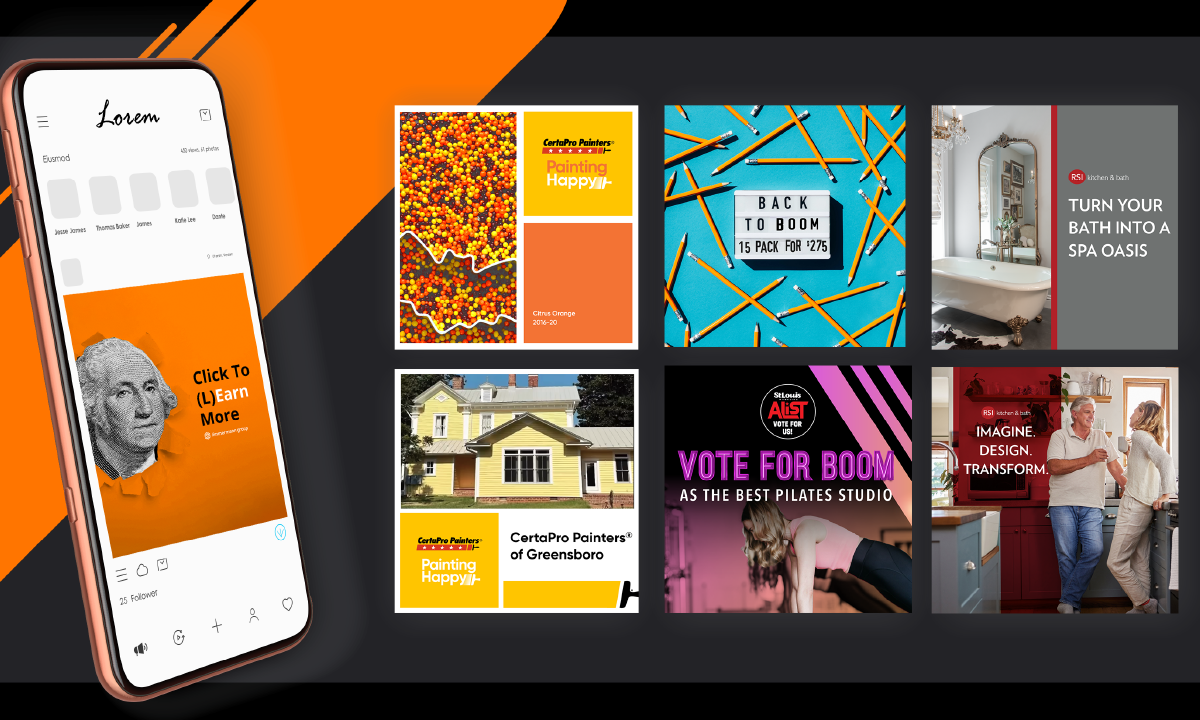Paid Social Ad Creative: 8 Tips and Best Practices
Social media marketing is a popular strategy amongst businesses looking to make a more personal connection with their customers. However, much like other types of marketing, the success of your campaigns is only as great as what you put out there and how you present your business. When it comes to creating effective social media campaigns, paid social ad creatives are pivotal to their success. The right creative captures the attention of your audience and drives key metrics like engagement, conversions, and brand awareness. Whether you’re aiming to boost reach, increase website traffic, or enhance your click-through rate (CTR), the quality of your ad creative can make or break your campaign.
The Role of Paid Social Ad Creative
Paid social media advertising is a powerful tool for reaching specific audiences with tailored messages. But what makes an ad stand out? The answer lies in the creative. Think about the last time you were scrolling your favorite social media platforms. What advertisements caught your eye and made you pause to watch a video, read for more information, or scroll through a carousel of products? Odds are it was something you felt appealed to you personally, fulfilled a need, or just made you smile. If it worked well enough, maybe you even visited their website to explore more, check pricing, or make a purchase.
Paid social ad creative serves as the bridge between your brand and your audience, influencing how they perceive your message and, ultimately, how they engage with your campaign. A well-crafted ad can spark interest, drive conversions, and elevate your brand’s presence across social media platforms.
Best Practices for Developing Your Paid Social Ads
1. Know Your Audience
Before diving into ad creation, it’s crucial to understand who your audience is. Your ads should be aligned with where potential customers are in the conversion funnel. Are they being introduced to your brand for the first time? Tell them the important facts and what they need to know about your business. Have they already visited your site, and you are running a retargeting campaign to recapture their attention? Make sure the ads are tailored to them so they want to come back and make a purchase or book your services.
It’s also important to recognize the broader range of individuals who may be influenced by your ad. For example, our client, Simon Law, ran a campaign for the medical condition necrotizing enterocolitis (NEC), which largely affects infants. Although the campaign targeted parents, the creative also needed to speak to extended family members, friends, and caregivers who may be advocates for these children.
2. Optimize Ads for Mobile

With the majority of users accessing social media via mobile devices, it’s absolutely vital to optimize your ads for mobile viewing. While the core creative might not change between mobile and desktop, the placement does — think reels, stories, and link previews. Additionally, your website should be mobile-friendly since most users will likely visit you through their mobile devices (92.3% of users access the internet using their mobile phones). A good rule of thumb to remember: When developing your ad creative, always adopt a mobile-first mindset.
3. Use Video Content – And Be Inclusive

Video content is a powerful tool in paid social advertising, but it needs to grab attention within the first three to five seconds to be effective. Inclusivity is key — ensure your videos are accessible to all types of viewers.
Consider Users Viewing Ads with Sound Off
Many users watch videos with the sound off, particularly if they’re in public places. In fact, a survey of American consumers aged 18-54 found that 69% of people watched videos without sound when in public places, and 25% kept the sound off even in private. Facebook is a great place for businesses to get social media video ads in front of consumers thanks to its large network of users, and sources have cited that 85% of these videos are watched on mute. The takeaway from this information? If users can’t visually decipher your ad’s message, it’s likely going to be ignored and perform poorly.
Don’t make sound an afterthought, though. For social platforms like TikTok, the sound you choose can be a vital piece of the video experience. Select a trending song or sound, and if your video includes individuals speaking, be sure to use a microphone or recording with minimal background noise.
Follow the Three Second Rule
One thing we’ve learned as digital marketers is that consumer attention spans are shrinking. When creating any kind of video marketing, especially those that will live on social media, you need to follow the three-second rule. Basically, you only have three seconds to grab your users’ attention and keep them interested. This isn’t a lot of time, so you need to be strategic about what goes here. You want people to know the video is coming from your business, but pushing your logo or brand immediately can make you seem pushy and result in viewers moving on. Instead, try attention-grabbing footage or images, startling yet relevant statistics, or answering the customers’ question, “What’s in it for me?” Being creative yet strategic with this brief time window will help you make the greatest impact.
Use Closed Captions & Text Overlays
Closed captions were generally used to help the hearing-impaired enjoy videos, but as more users watch videos without sound, they’ve become useful for all viewers. Many want to enjoy video content without having to turn the sound on and disturb others around them. Not only are captions useful, but they actually boost your video’s performance. In fact, it was discovered that 80% of survey respondents would watch a video through to the end if captions were available. PLY Media also found that 66% of videos without captions were watched to completion, compared to 91% of videos with captions. In short, including text in your videos through captions and text overlays works to increase viewer comprehension, encourage greater user engagement, increase video social reach, and even improve SEO.
If you use text overlays in static images, keep it to 25% of the image or less. Text on an image should be short, sweet, and to the point. Think of it as a billboard on the highway; you only have a brief time to deliver your message as drivers head to their destination. They don’t have long to take their eyes off the road and read, so you must make it quick.
4. Keep Any Creative Authentic
Whether you post an image or a video, authenticity is vital in today’s social media environment. Many businesses are still hung up on creating videos with high-quality, high-production value and are afraid of putting out anything that looks too DIY. Professionally created videos and images are great, but they’re also expensive. They can also make you feel a little out of touch with your target audience on social media. This doesn’t mean taking it too far in the opposite direction and shooting random videos and pictures with your phone. Not every ad needs to be “studio-quality,” but each should strike a balance between professionalism and relatability.
For example, a casual yet well-produced video filmed on a newer iPhone using a ring light and quality microphone can resonate well if it aligns with your brand’s voice. When you’re trying to create content that feels genuine yet polished, think of the latest TikTok trends, product unboxing, or behind-the-scenes content.
5. Leverage User-Generated Content
User-generated content (UGC) is a goldmine for paid social ads. It offers authentic insights from real users, which can significantly boost credibility and trust in your brand. As content creators and advertisers, we’re always encouraged to “show, don’t tell.” UGC is completely unique to your brand, and customers can see people they actually relate to enjoying your products. Seeing it out in the “real world” will always be more beneficial than simply reading about what it offers. Think about all of those consumer-made product review videos or the amount of consumer images people share to show how well an item of clothing fits — people want to know what they’re getting before they click the “buy” button.
In addition to obtaining UGC organically from customers by asking for it, you can also request participation from influencers. Incorporating UGC, particularly through influencer campaigns, can provide a unique perspective on your products and resonate more deeply with your audience.
6. Recognize Brand Guidelines, But Get Creative
Brand guidelines were created to ensure brand recognition across various marketing platforms. Consistency with brand guidelines is essential, but don’t be afraid to occasionally push the boundaries, especially regarding social media. Creativity within the framework of your brand can lead to standout ads that capture attention. Sometimes, loosening the rules a bit can result in more engaging and memorable content. A relaxed view of your brand guidelines opens the door to user-generated content involving your target audience. More than likely, this content won’t strictly adhere to your brand guidelines, but it can be a great source of relatability outside of an overly polished image or video.
When advertising on social media platforms, you also want your authenticity to take priority. As users scroll their newsfeeds, they’re more likely to ignore the posts that look like paid ads. However, when they see content that looks like something a friend posted, they’re more likely to stop and take a look. That brief moment of grabbing their attention could be enough to get them to explore your brand even more, especially if you are presenting them with relevant and timely ads rather than a mass-marketed message.
7. Create Ads that Reflect Your Audience

Representation matters. Ensure your ads reflect the diversity of your audience, both in terms of who they are and what they look like. Feature different genders, various ages, sizes, ethnicities, families, and more to broaden your appeal and make it feel inclusive to your audience rather than exclusive. By doing so, your ads will be more relatable and resonate more strongly with the people you’re trying to reach.
8. Test Your Ads and Analyze Performance
Testing is a crucial step in refining your paid social ad strategy. Customer needs and wants are always evolving, so continually pushing one type of message that worked in the past is a sure way to lose customers in the future. A/B testing different versions of your ads allows you to see what resonates best with your audience. Different options allow you to appeal to different audiences across various platforms. Once the ads are live, analyzing performance metrics like CTR, conversions, and engagement will provide valuable insights to optimize future campaigns and better meet your customers’ needs.
Make an Impact with Effective Paid Social Ad Creative from TG
Incorporating these best practices into your social ad strategy can significantly enhance your campaign’s effectiveness, driving better engagement and stronger results. Of course, trying to run a business while creating effective marketing strategies takes a lot of work, especially if it’s not a task you’re used to. Partner with an experienced marketing agency to ensure your ads make a lasting impact. Partner with the social media marketing experts at Timmermann Group.
Contact us today and get started on elevating your social media ad campaigns.

